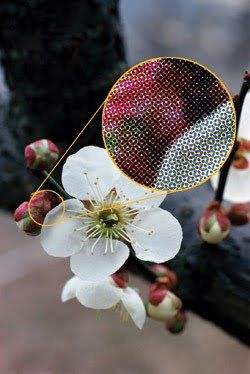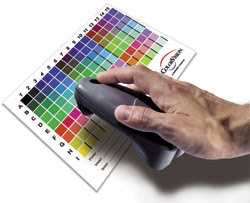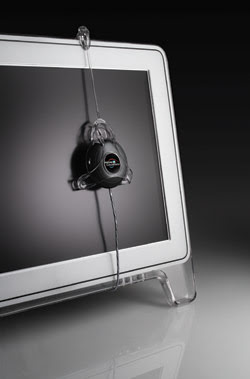Color management, a field of study that has come of age in the past decade, is yielding practical solutions and interesting products.
Dr. Christine Connolly, Contributing Editor
After scanning a color photograph into a computer, one assumes it will reproduce well on the screen and
on those to which it has been sent via the Internet. The ease with which this can
now be done, however, conceals the complexity of the underlying technology and the
challenges involved in getting various input and output devices to reproduce colors
well. The reason is that one monitor may use red, green and blue (RGB) primaries
with additive mixing, while the printer has cyan, magenta, yellow and black (CMYK)
primaries with subtractive mixing.

According to Adobe scientists, because humans can't distinguish separate cyan,
magenta, yellow and black dots in an image at normal viewing size, they instead
perceive colors. These are simply an additive combination of varying amounts of
CMYK inks in any section of the image.
In the past 20 years, a field of study called
color management has emerged to address the problem of color rendering by multiple
devices. Perhaps one of the earliest applications involved prepress systems for
publishing applications. All components were single-source and used proprietary
hardware and software. Accuracy of color reproduction depended on the manufacturers’
knowledge of the input and output devices and the development of the appropriate
transforms to map colors from an analyze scanner to the workstation screen and from
the screen to an expose scanner.
Another early application involved
textile design. Research at the University of Manchester Institute of Science
and Technology in the UK, for example, led to the development of the Shademaster,
a system that allows a designer to create a color on-screen and to output its numeric
color definition so that dyers can calculate its formulation. Researchers also calibrated
the required color printers so that the color would reproduce well on paper.
Around the same time, the Colour and
Imaging Institute of the University of Derby in the UK was working independently
on calibrating monitors to display color order systems such as Munsell (an established
communication tool in dye houses) on-screen and to display the CIE tristimulus
X-Y-Z values of a user-selected sample. The university also went on to calibrate
color cameras so that colors could be scanned in from them.
Toward the end of the 1980s, manufacturers
began developing desktop publishing systems for standard computers. At first, each
company pursued its own path, and every color-management system had a different
architecture. As Seattle-based Microsoft explains on its Web site, when each application
uses a different proprietary system, it is impossible to get consistent color interchange
among the different applications. Apple of Cupertino, Calif., addressed the problem
with a software system called ColorSync that provides a framework within the operating
system for exchanging color information between applications and between input and
output devices.
Then in 1990, Eastman Kodak Co. in
Rochester, N.Y., announced the development of its Photo CD system and a proposed
worldwide standard for defining color in the digital environment of computers and
computer peripherals. In 1993, the firm banded together with Microsoft, with Apple,
with Agfa in Mortsel, Belgium, and with Sun Microsystems, Adobe and Silicon Graphics,
all in California, to form the International Color Consortium (ICC).

To build an International Color Consortium profile of a CMYK printer, a spectro colorimeter measures 125 color
patches, and the data is fed to color-management software for computation. Courtesy of DataColor.
Attacking the problem
One area to benefit from subsequent standards
work of the consortium was prepress. While transforms for high-end proprietary prepress
systems may work well when mapping colors between a pair of devices, they are not
suitable in environments using a variety of scanning devices and cameras, and many
different output printers, all connected to the computer via plug-and-play drivers.
This led the consortium to adopt device-independent transformations.
These transforms map each device to
one standard color space. Called the profile connection space, it provides a common
language for device communication. A new device introduced to an application thus
requires just one transform to the standard space. Its ICC profile contains the
transform to the connection space in the form of a look-up table with either 8-
or 16-bit data per channel.
The profile has a closely specified
format, so that many users can access it readily and reliably. Input profiles translate
the native metrics of an input device, such as a scanner or camera, into the profile-connection-space
values. Output profiles apply to output devices, such as printers, and they translate
profile correction space data into signals that determine the quantity of each color
of ink applied to the paper.
The process of building an ICC profile
is called device characterization. It relates the color characteristics of a device,
such as a computer monitor, to the color space. But the profile will be used on
many of these monitors in many places, so it is essential that they all behave the
same. Walk through an electronics shop with various television sets on the same
channel, and it becomes obvious that the color and contrast can differ dramatically
from screen to screen. Each may receive the same image but may render it differently
because of differences in brightness, color balance and contrast settings. Getting
consistency among monitors requires that they be calibrated to display the same
colors.
The characterization process relates
the native color space of the device to the profile connection space. For example,
scanner characterization may use a printed target consisting of patches of uniform
color. The scanner produces an R, G and B signal from each of its pixels. The process
involves calculating the average R, G and B value for each patch and relating the
data to the Commission Internationale de l’Eclairage (CIE) X-Y-Z values of
the same patch as measured by a spectrophotometer. The ICC profile includes a header
that contains information such as the medium white point, data type and size, and
information that is used within a specific vendor’s applications.
The whole gamut?
A major problem when transferring colors from
device to device is gamut mismatch. The gamut is the range of colors producible
by mixing primaries. It is impossible to produce colors that are more pure than
the primary ones, so each device has a limited gamut, and the gamuts of different
devices vary.
It may be possible to scan some particularly
bright colors from a photographic film, yet be impossible to print those colors
with CMYK primaries. Only the in-gamut colors transform accurately into the color
space data. So the question becomes what to do about the out-of-gamut colors.
The ICC profile contains a collection
of rendering intents that enable different solutions, depending on circumstances.
In the example above, where the printer has a smaller gamut than the scanner and
the aim is to produce a pleasing reproduction rather than an exact color match,
the user would choose the perceptual rendering intent. This expands or compresses
the full gamut of the image to fill the gamut of the destination device. It keeps
the gray balance correct and ensures that the overall scene appearance is acceptable.
The colors bear a similar relationship to each other, as they did in the original,
although they do not actually match color for color, even within their common gamut.
For proofing, for example where a monitor
simulates the appearance of a printed design or where an ink-jet printer simulates
the appearance produced by a printing press, the solution would involve the use
of colorimetric intent to ensure that individual colors within the common gamut
match exactly. Saturation intent finds use in business graphics, where bright, eye-catching
colors are important. This strategy preserves the saturation of the pixels in the
image, even though there may be a change in hue and lightness.
Software aids
Once the ICC profile has been produced for a particular
device, one can use it as part of a color-management system. It requires a color-management
software module that interpolates between the look-up table entries of the profiles
and allows one device to communicate color to another. Photoshop includes such software,
as do the Macintosh and Windows operating systems.
The color-management system in Windows
works without user intervention, loading the ICC profile of a printer or scanner
as part of its installation and automatically using it whenever the device is operated.
An override, however, allows one to specify which profile to use with a particular
device.
As equipment ages, it changes its behavior,
and thus requires a calibration procedure. Proper calibration ensures that colors
will be acceptable in all the reproduction media. Color-management software does
not solve the problems completely, but it does give a generally acceptable level
of control over what was previously a very hit-and-miss affair.
The ICC profiling approach to color
management makes the user responsible for maintaining equipment calibration and
for using the appropriate profile for each device. In parallel with this, vendors
supplying the consumer market started using a standard-default color-management
approach called sRGB. It has gained the status of an international standard and
is implemented in virtually every computer input and output device and on the Internet.
Based on the color space of traditional
cathode-ray-tube monitors, the standard takes into account the colorimetric properties
of their phosphors and their nonlinear display characteristics. It is a device-dependent
color space, but this device has long been subject to the international standards
of television broadcasting.
This inexpensive means of color-management
works without intervention by the user and usually without the user realizing it
is there. Input device manufacturers build transformations from native color space
to sRGB, and printer manufacturers build the sRGB to CMYK transforms.
Products and tools
The main outcome of a decade of work by the ICC
is a set of standards that are accepted and used by the membership. Information
about color-management theory and practice is available on the consortium’s
Web site (www.color.org). In addition, the member companies have produced a collection
of products that make the practice of color management readily accessible to professionals
who work in markets where color use is routine.
Some software tools allow end users
to build their own ICC profiles. For example, Eastman Kodak offers an ICC Input
Profile Builder and ColorFlow tools that enables digital imaging and photographic
professionals to develop and maintain custom ICC profiles for devices. For input
devices, these scan the colors in a standard target, compute a best-fit function
to relate them to X-Y-Z values, and produce a look-up table. The mathematical procedure
for finding the best-fit function is proprietary to the software manufacturer. For
an output device, the software causes the device to print a set of uniformly colored
patches. The end user must measure the colors produced with a color-measuring instrument,
and the software will use this data to relate the CMYK recipe to the actual colors
printed.
There are calibration aids, such as
targets produced by Gretag Macbeth, and color-measuring instruments from Gretag
in Zurich, Switzerland; X-Rite Inc. in Grandville, Mich.; Datacolor in Lawrenceville,
N.J.; and Color Savvy Systems Ltd. in Springsboro, Ohio. To calibrate a monitor,
there are visual procedures such as Adobe Gamma, a utility built into Photoshop
that generates an ICC profile for a particular monitor. A more accurate calibration
involves the use of a special colorimeter to measure the colors on-screen.

To characterize the colorimetric properties of a display,
end users can attach a special colorimeter such as this LCD Spyder to the screen
while it displays a test pattern of colors.
Other color-management tools use the
profiles to make input and output devices work together. For example, Photoshop
allows artists to create images from scratch and to retouch and modify existing
pictures. QuarkXPress enables the control of layout and design, text processing
and color imaging when preparing print publications and Web pages.
The current ICC Profile Specification
3.4 supports Apple, Microsoft, Silicon Graphics Inc., Java and Sun operating systems.
For example, Apple’s ColorSync, which is built into the Mac operating system,
stores ICC profiles as part of the image file to specify how the image was captured
and in what color space. Included is a monitor calibration system that corrects
any irregularities in the monitor’s age, phosphor set, ambient light, white
point and monitor type. End users also can calibrate monitors to ensure that colors
of a displayed image correspond to those within the original photograph and can
view how an image would appear in hard copy using different paper types and printers.
The tools find use in high-end and
professional graphic arts and photographic devices. By creating custom profiles
for their equipment, color laboratories can achieve better-quality color reproduction,
especially when transferring images to a wide range of media, such as murals, exhibition
stands and brochures. Kodak’s Web site describes how one of its ColorFlow
users produced a 40-foot-long color print on transparent film that was applied to
the sides of a white van to advertise a local zoo.
Apple’s ColorSync has been used
recently to produce a series of reproductions of oil paintings on vitreous enamel
panels displayed along a 450-foot passage in the Tower Hill underground station
in London. This was commissioned by the Historic Royal Palaces to make tourists
aware of the museum of expressionist art at the Tower of London. It is the vibrancy
of color in the original paintings that makes them so attractive, so it was vital
to retain accurate color rendering in this vandal-proof medium.
Color management tools continue to
evolve. Datacolor now sells Shademaster technology under the name ImageMaster.
Retailers use it, as do their suppliers in the apparel industry. Fashion designers
develop colors for the coming season on-screen, and the system outputs the CIE X-Y-Z
specifications required by dye houses to reproduce the colors on fabrics. An integral
quality control system assesses dyers’ samples and produces a pass/fail verdict
against the original color. As another example, Derby’s ColourTalk system
has been developed further in collaboration with Coats Viyella and Fuji Film Electronic
Imaging to communicate precise color specifications among remote locations.